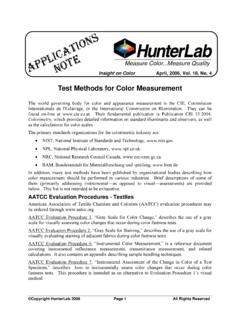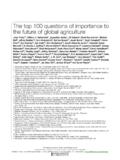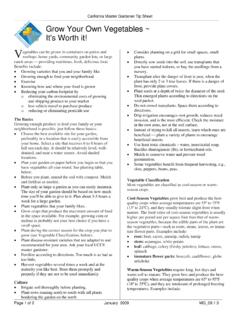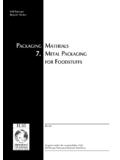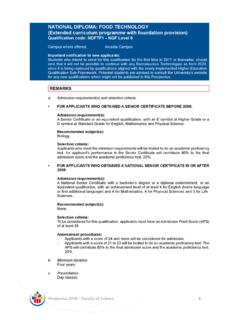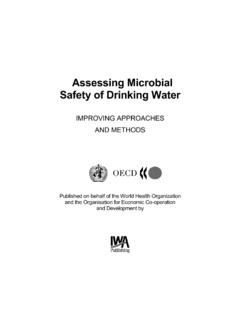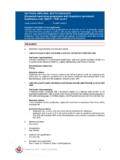Transcription of of Shelf life of Raw Nuts Held at Different …
1 1 Estimates of Shelf life of Raw Nuts Held at Different Temperatures Important factors for nut quality include drying to low moisture content and packaging in moisture proof bags. Since nuts in shells are often handled loose, temperature will be important to maintain quality and Shelf life as summarized in Table 1. The estimates in Table 1 take into account information on quality and food safety changes at Different temperatures. The main quality concerns are rancidity (oxidation of lipids leading to off flavors), darkening (related to initial drying temperature and subsequent storage conditions), mold growth (moisture and temperature dependent), brittleness (moisture content too low), insect infestation, and stale flavor (held too long under the given storage conditions). The main food safety concerns for nuts are aflatoxins produced by fungi and human pathogenic bacteria (Salmonella sp.)
2 , Listeria monocytogenes); both food safety aspects are affected by the moisture content and temperature of the nut. Some nuts, especially peanuts, may cause allergic reactions in some people. The moisture content of common nuts in refrigerated storage should be near the following percentages: almonds 6%, Brazil nuts 7%, cashew nuts 8%, coconut 20%, hazelnuts 15%, macadamia nuts 15%, pecans 5%, peanuts 7%, pistachio nuts 7% and walnuts 5%. The optimum relative humidity of storage varies from 55 70% depending on the moisture content of the nuts. Packaging in moisture proof containers is recommended to maintain quality. The higher the temperature, the more critical is relative humidity and moisture content. Coconuts and chestnuts have high moisture contents and should be considered more as fresh fruits . Nuts in the shell have 25 50% longer Shelf life than the nutmeats alone; this percentage can vary considerably depending on the particular nut and whether the packaging provides a moisture barrier and/or a low oxygen concentration.
3 Pieces of nutmeats have about half the Shelf life of the intact nutmeats. Some roasted nuts have a Shelf life about one fourth that of the raw nutmeats. In general the optimal storage temperature is 0 10C with relative humidity at 55 70%, depending upon the original moisture content of the nut. Key Sources of Information Bruhn, C., Harris, M. Giovanni, and D. Metz. 2010. Nuts: Safe Methods for Consumers to Handle, Store and Enjoy Almonds, Chestnuts, Pecans, Pistachios, and Walnuts. UC ANR Publication 8406. Kader, and Thompson. 2002. Postharvest handling systems: Tree nuts. Ch 32, pp 399 406. In: Kader, (ed.), Postharvest Technology of Horticultural Crops. Univ. California Publication 3311. Kader, , Mitcham and C. Crisosto. 1998. Dried fruits and nuts: Recommendations for maintaining postharvest quality. 2 Harris, (ed.) 2013. Improving the safety and quality of nuts.
4 Woodhead Publishing Series in food Sciences, Tech. and Nutrition Number250, Woodhead Publishing, Cambridge, UK. 405 pp. Perry, E., Harris, M. Giovanni, D. Metz, and C. Bruhn. 2010. Nuts: Safe Methods for Home Gardeners to Handle, Store and Enjoy Almonds, Chestnuts, Pecans, Pistachios, and Walnuts. UC ANR Publication 8407. Table 1. Estimate of months of Shelf life of raw nuts (in shell or intact nutmeats) at Different temperatures. Estimates are derived from the general published reference list and the specific references cited in the table. If the nutmeats are packaged, it is assumed that relative humidity is controlled but oxygen concentrations are not substantially Different from air. It is also assumed the nuts were dried adequately before storage. Estimate of Shelf life in months Nut type 10 C ( 14 F) 0 C (32 F) 10 C (50 F) 20 C (68 F) 30 C (86 F) References Almond nutmeat 10 8 4 Labavitch, 2004; Cornacchia et al.
5 , 2012 In shell 20 16 6 Labavitch, 2004 Cornacchia et al., 2012 Brasil nut nutmeat 6 WFLO, 2008 In shell 12 WFLO, 2008 Cashew nutmeat 12 6 Soares et al., 2012; WFLO, 2008 Chestnut In shell Do not freeze 3 Kader, 2003; Panagou et al., 2006 Coconut In shell, no husk 2 TIS, undated; Siriphanich et al., 2011 In green husk 2 1 Maciel et al., 1992; Siriphanich et al., 2011 Hazelnut nutmeat 24 12 Maness, 2004 In shell 24 12 WFLO, 2008 Macadamia nutmeat 24 12 12 5 Cavaletto, 2004; Wall, 2013 Peanut nutmeat 24 12 9 4 WFLO, 2008; Maness, 2004; Calhoun, 2013 In shell 12 9 6 Maness, 2004; Ortloff ,2009 Pecan nutmeat 18 10 3 Maness, 2004 In shell 24 18 9 4 WFLO, 2008; Maness, 2004 Pine Nut nutmeat Pistachio Nutmeat 10 3 1 Arena et al., 2013; Kader & Thompson, 2002 In shell, split 12 Maskan et al., 1999 Walnut Nutmeat 12 3 Mexis et al.
6 , 2009; Kader and Thompson, 2002 In shell 12 4 McNeil, 2013 Average* 10 4 *The average excludes high moisture chestnuts and coconuts 3 Reference List Alasalvar, C. and F. Shahidi (eds.). Tree Nuts. Composition, phytochemicals and health effects. Nutraceutical Science and technology Series, CRC Press, Boca Raton. Arena, E., G. Ballistreri and b. Fallico. 2013. Effect of postharvest storage temperatures on the quality parameters of pistachio nuts. Czech. J. food Sci. 31: 467 473. Beuchat, and Pegg. 2013. Improving the safety and quality of pecans. Ch 13, pp. 297 329. In: Harris, (ed.), Improving the safety and quality of nuts. Woodhead Publishing Series in food Sciences, Technology and Nutrition Number250, Woodhead Publishing, Cambridge, UK. Bolling, , C. Y. O. Chen, McKay and Blumberg. 2011. Tree nut phytochemicals: composition, antioxidant capacity, bioactivity, impact factors.
7 A systematic review of almonds, Brazils, cashews, hazelnuts, macadamias, pecans, pine nuts, pistachios and walnuts. Nutrition Res. Rev. 24: 244 275. Bruhn, C., Harris, M. Giovanni, and D. Metz. 2010. Nuts: Safe Methods for Consumers to Handle, Store and Enjoy Almonds, Chestnuts, Pecans, Pistachios, and Walnuts. UC ANR Publication 8406. Calhoun, S. 2013. Improving the quality and safety of peanuts. Ch 14, pp. 330 349. In: Harris, (ed.), Improving the safety and quality of nuts. Woodhead Publishing Series in food Sciences, Technology and Nutrition Number250, Woodhead Publishing, Cambridge, UK. Cavaletto, 2004. Macadamia nut. In: The Commercial Storage of Fruits, Vegetables, and Florist and Nursery Stocks ( Gross, Wang and M. Saltveit, eds.). USDA Agricultural Handbook 66. Cornacchia, R., Amodio and G. Colelli. 2012. Effects of storage temperature and duration on quality of unshelled and shelled almonds.
8 Acta Horticulturae 934: 783 790. Ghiradello, D., C. Contessa, N. Valentini, G. Zeppa, L. Rolle, V. Gerbi, R. Botta. 2013. Effect of storage conditions on chemical and physical characteristics of hazelnut (Corylus avellana L.). Postharvest Biology and Technology 81: 37 43. Harris, (ed.) 2013. Improving the safety and quality of nuts. Woodhead Publishing Series in food Sciences, Technology and Nutrition Number250, Woodhead Publishing, Cambridge, UK. 405 pp. Harris, Uesugi, Abd, McCarthy. 2012. Survival of Salmonella enteritidis PT 30 on inoculated almond kernels in hot water treatments. food Research International 45: 1093 1098. Harris, and L. Ferguson. 2013. Improving the safety of almonds and pistachios. Ch 15, pp. 350 378. In: Harris, (ed.), Improving the safety and quality of nuts. Woodhead Publishing Series in food Sciences, Technology and Nutrition Number250, Woodhead Publishing, Cambridge, UK.
9 Irtwange, and Oshodi. 2009. Shelf life of roasted Cashew Nuts as affected by relative humidity, thickness of polythene packaging material and duration of storage. Research J. Applied Sciences, Engineering and Technology 1(3): 149 153. 4 Kader, 2003. Chestnut: Recommendations for maintaining postharvest quality. Kader, 2013. Impact of nut postharvest handling, de shelling, drying and storage on quality. Ch 2, pp. 22 34. In: Harris, (ed.), Improving the safety and quality of nuts. Woodhead Publishing Series in food Sciences, Technology and Nutrition Number250, Woodhead Publishing, Cambridge, UK. Kader, and Thompson. 2002. Postharvest handling systems: Tree nuts. Ch 32, pp 399 406. In: Kader, (ed.), The Postharvest Technology of Horticultural Crops. Univ. California Publication 3311. Kader, , Mitcham and C. Crisosto. 1998. Dried fruits and nuts: Recommendations for maintaining postharvest quality.
10 Labavitch, J. 2004. Almond. In: The Commercial Storage of Fruits, Vegetables, and Florist and Nursery Stocks ( Gross, Wang and M. Saltveit, eds.), USDA Agricultural Handbook 66. Labavitch, J. 2004. Pistachio. In: The Commercial Storage of Fruits, Vegetables, and Florist and Nursery Stocks ( Gross, Wang and M. Saltveit, eds.). USDA Agricultural Handbook 66. Labavitch, J. 2004. Walnut. In: The Commercial Storage of Fruits, Vegetables, and Florist and Nursery Stocks ( Gross, Wang and M. Saltveit, eds.). USDA Agricultural Handbook 66. Ledbetter, and Palmquist. 2006. Degradation of almond pellicle color coordinates at Different storage temperatures. Postharvest Biology and Technology 40: 295 300. Little, , W. Jemmott, S. Surman Lee, L. Hucklesby, and E. de Pinna. 2009. Assessment of the microbiological safety of edible roasted nut kernels on retail sale in England, with a focus on Salmonella.

